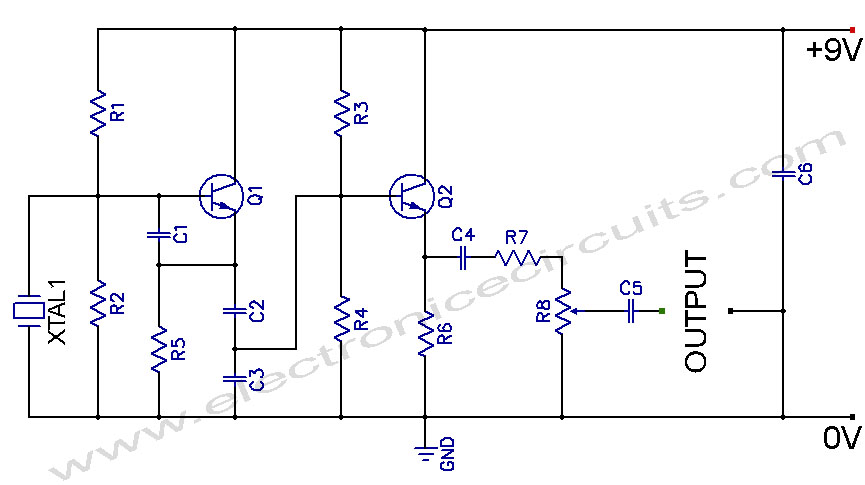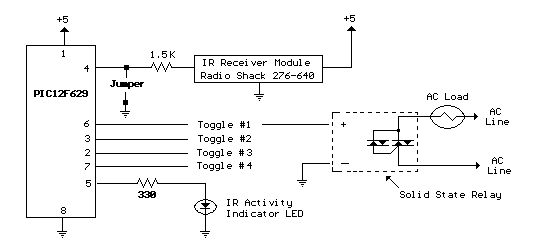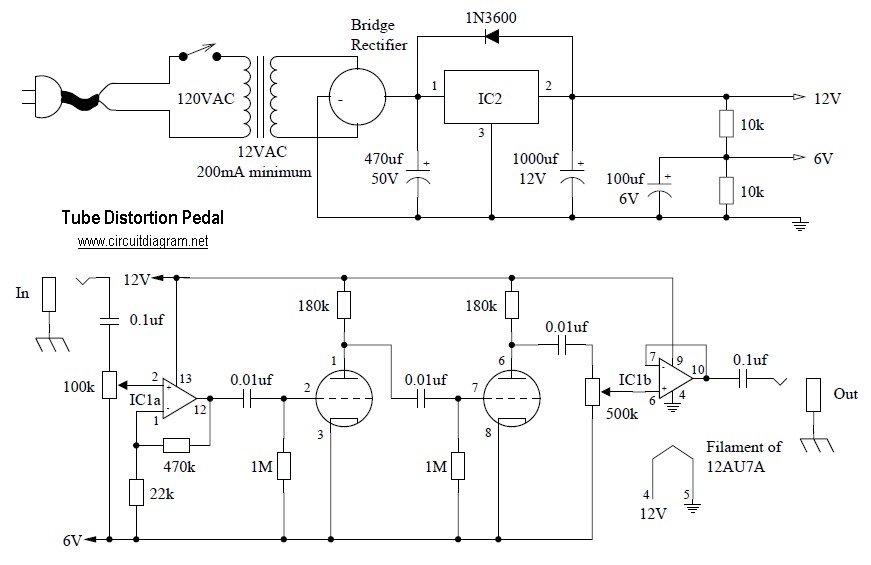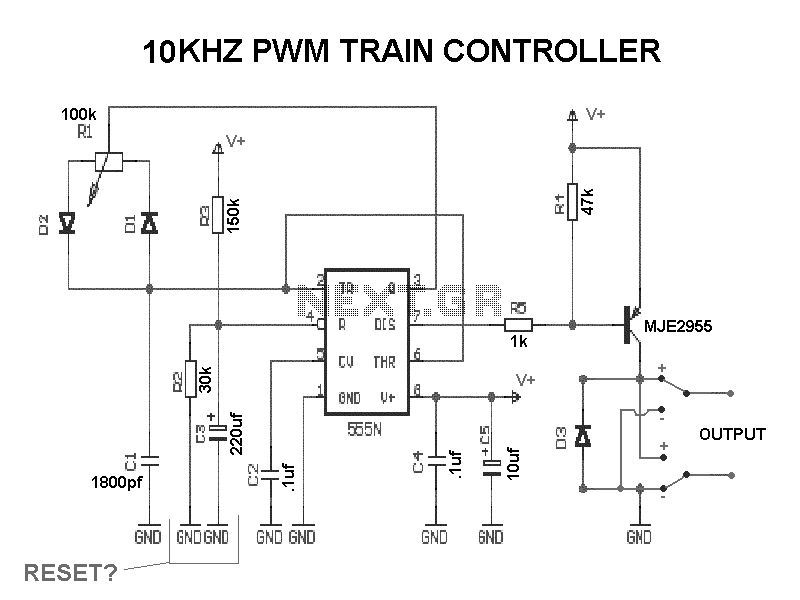
Tube preamp tone control
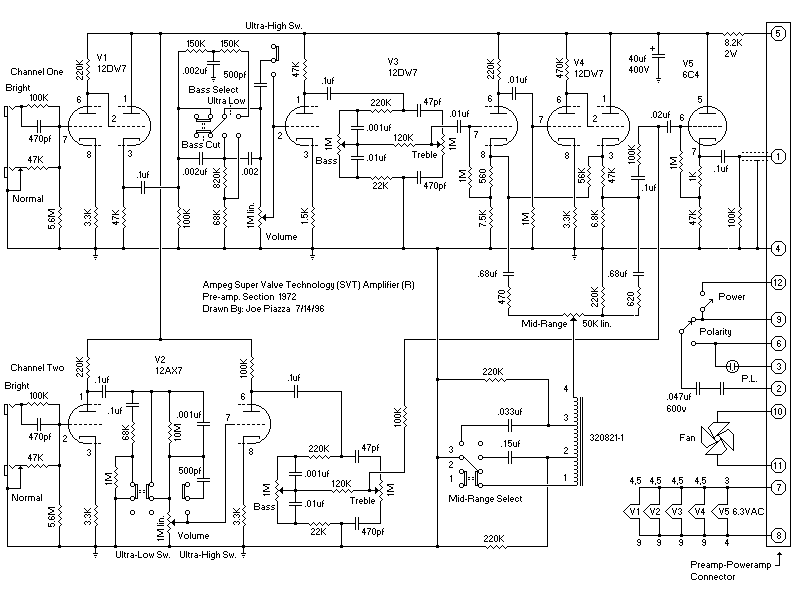
The +/- 3 dB point for the treble is approximately 2.5 kHz, with a boost/cut of about 12 dB at 10 kHz. It may be necessary to check the wiring or component values. Access to a signal generator is recommended. The wiring and components have been checked multiple times, and linear pots were used instead of logarithmic pots, but the circuit is still not functioning. The "Ultra High" switch has minimal effect on the output tone, and the issue in the treble section is unclear. Regular capacitors were used throughout the circuit; it is uncertain if special components are required. The "Ultra High" switch is intended for treble accentuation, but it is ineffective. Simulation of the circuit indicates that the U-H circuit is volume control dependent. At half volume, the treble is +3 dB at 650 Hz and +8 dB at 10 kHz. With the volume set lower, the +3 dB point is at 400 Hz, and the response at 10 kHz is +15 dB. This indicates a significant treble increase, which may render the switch unnecessary. It is advised to keep the switch off until the pre-amp is functioning correctly. The apparent lack of impact from the switch suggests a need to check the tubes, specifically measuring the voltages. The ECC83 anode voltages should be between 90V and 150V, while the cathodes should be around 1-2V. The use of a signal generator is encouraged to verify gain. Testing the tone control circuit separately by detaching it from the 2nd ECC83 anode and using the signal generator is also recommended, with expectations of +/- 8 dB response at 10 kHz. Additionally, it is important to confirm if the bass control functions properly. The circuit feeds into a load without an isolating stage, and for optimal operation, the load impedance should be at least 500K. The output impedance of the tone control is 140K, and excessive loading may adversely affect the response. Simulation results indicate that the treble control has minimal effect, primarily functioning as a treble cut. Testing with the James tone stack values yielded improved results. It is suggested to utilize Duncan's tone stack simulator to explore various component values. A simulation of the tone control section, with a 120K input resistance, indicated a +3 dB point at 3.2 kHz for full treble boost and a -3 dB point at 5.2 kHz for full treble cut. The output was unloaded, and the bass control was set to midpoint, resulting in a typical unsymmetrical response characteristic of passive tone controls.
The described circuit appears to be a tone control section of an audio preamplifier, specifically focusing on treble and bass adjustments. The treble control is designed to adjust the frequency response at higher frequencies, with a specified behavior at 2.5 kHz and 10 kHz. The presence of an "Ultra High" switch suggests an additional feature intended to enhance treble frequencies, but its ineffectiveness indicates potential issues within the circuit.
The simulation results provide insight into the circuit's behavior under various conditions, indicating that the treble response is highly dependent on the volume control settings. This dependency highlights the importance of ensuring that the operational parameters of the circuit are well understood and optimized for desired audio performance.
The use of linear potentiometers in lieu of logarithmic ones may also contribute to the observed issues, as logarithmic pots are typically preferred in audio applications for their more natural response to human hearing. The suggestion to check the tube voltages is critical, as the ECC83 (12AX7) tubes play a significant role in the gain and overall tonal characteristics of the circuit. Ensuring that the tubes are functioning correctly and within specified voltage ranges is essential for achieving the expected performance.
Furthermore, the output impedance of the tone control circuit must be matched with the load impedance to avoid loading effects that could degrade the audio signal. The recommendation to simulate the circuit with various component values using a tone stack simulator is a practical approach to fine-tuning the response characteristics and achieving the desired tonal balance.
In conclusion, the successful operation of this tone control circuit hinges on careful attention to component selection, circuit configuration, and thorough testing to ensure that all elements are functioning as intended. Proper troubleshooting and adjustments based on simulation data will facilitate optimal performance and enhance the overall audio experience.The +/- 3 dB point for the treble is about 2, 5 KHz, with about 12 dB boost/cut at 10 KHz. Perhaps you should check the wiring (again ) or perhaps componentvalues Do you have access to a signal generator yeah i checked wiring and components again and again, i used linear pots cuz there s no log pot here, but still it s not working, in fact the the u-hi switch has a very very small change in output tone too, i donno where s the problem in treble section. i used regular caps in whole circuit, should i use anything special But first: I presume that "Ultra High" switch is meant for some high treble accentuation (presence ), but it does not do that at all! I simulated your circuit on a computer programme. Firstly, the U-H circuit will be volume control dependent as you are probably aware of. But with the volume control set about half-ways, the treble is +3 dB already at a frequency of 650 Hz, and 8 dB up at 10 KHz.
With the volume control further down (15% from 0), the +3 dB point is 400Hz and the response at 10 KHz up by 15 dB. That is not at all "ultra-high", and also quite a substantial treble increase! I would imagine you can do without it at all, but let us at least do things one at a time, and keep that switch off until the rest of the pre-amp is working.
Also then, with the substantial difference that switch should make but does not, may I suggest you first check whether the tubes are working at all, i. e. measure the voltages (with a digital meter if you can). I would place the ECC83 anode voltages at 90V - 150V, with the cathodes at a volt or two. Use the signal generator to determine that you have reasonable gain at all. Do you have a scope Further to that you can check the tone control circuit alone, by detaching it from the 2nd ECC83 anode and feeding it directly with your signal generator.
(Now you will need a scope. ) The treble should give a response between +/- 8 dB or so at 10 KHz. Two final points, which I should maybe have asked first. You mention only the treble; does the bass control work adequately Then I see the circuit you use (the first one quoted) feeds out into whatever load you have, without another isolating stage (the circuit giving the values has further stages which I understand you do not use). Be aware that for proper operation of the tone controls the "load" you feed them into must have an impedance of at least 500K or more.
(The output impedance of your tone control alone is 140K, which must not be loaded appreciably otherwise the response will suffer. ) I ran a simulation of the circuit using Multisim 8 and the treble control does indeed do almost nothing (treble cut only) I then tried the values shown for the James tone stack in Duncans tone stack simulator and these values worked much better.
If you don`t already have it download a copy from Duncan`s site and use it to try different values I`m sure you will find something that works. Before we confuse Ahmad; Retailer, I have simulated the tone control section only, on P. Spice, using in serie with the signal generator an input resistance of 120K to the tone circuit proper, to guestimate a rather high rp from the tube (because of current feedback) somewhat shunting the plate load of 150K.
(It might well be a little lower than 120K. ) Relative to 1 KHz I found for full treble boost a +3 dB point at 3, 2 KHz, with 10 dB boost at 10 KHz and climbing. Going to full treble cut I found a -3 dB point at 5, 2 KHz, with treble cut at 10 KHz of 7, 3 dB and decreasing.
The tone control output was unloaded and the bass control at mid-point. This represents the normal somewhat unsymmetrical response typical of this type of passive tone control. (I also found the bass variation somewhat overpowering and 🔗 External reference
The described circuit appears to be a tone control section of an audio preamplifier, specifically focusing on treble and bass adjustments. The treble control is designed to adjust the frequency response at higher frequencies, with a specified behavior at 2.5 kHz and 10 kHz. The presence of an "Ultra High" switch suggests an additional feature intended to enhance treble frequencies, but its ineffectiveness indicates potential issues within the circuit.
The simulation results provide insight into the circuit's behavior under various conditions, indicating that the treble response is highly dependent on the volume control settings. This dependency highlights the importance of ensuring that the operational parameters of the circuit are well understood and optimized for desired audio performance.
The use of linear potentiometers in lieu of logarithmic ones may also contribute to the observed issues, as logarithmic pots are typically preferred in audio applications for their more natural response to human hearing. The suggestion to check the tube voltages is critical, as the ECC83 (12AX7) tubes play a significant role in the gain and overall tonal characteristics of the circuit. Ensuring that the tubes are functioning correctly and within specified voltage ranges is essential for achieving the expected performance.
Furthermore, the output impedance of the tone control circuit must be matched with the load impedance to avoid loading effects that could degrade the audio signal. The recommendation to simulate the circuit with various component values using a tone stack simulator is a practical approach to fine-tuning the response characteristics and achieving the desired tonal balance.
In conclusion, the successful operation of this tone control circuit hinges on careful attention to component selection, circuit configuration, and thorough testing to ensure that all elements are functioning as intended. Proper troubleshooting and adjustments based on simulation data will facilitate optimal performance and enhance the overall audio experience.The +/- 3 dB point for the treble is about 2, 5 KHz, with about 12 dB boost/cut at 10 KHz. Perhaps you should check the wiring (again ) or perhaps componentvalues Do you have access to a signal generator yeah i checked wiring and components again and again, i used linear pots cuz there s no log pot here, but still it s not working, in fact the the u-hi switch has a very very small change in output tone too, i donno where s the problem in treble section. i used regular caps in whole circuit, should i use anything special But first: I presume that "Ultra High" switch is meant for some high treble accentuation (presence ), but it does not do that at all! I simulated your circuit on a computer programme. Firstly, the U-H circuit will be volume control dependent as you are probably aware of. But with the volume control set about half-ways, the treble is +3 dB already at a frequency of 650 Hz, and 8 dB up at 10 KHz.
With the volume control further down (15% from 0), the +3 dB point is 400Hz and the response at 10 KHz up by 15 dB. That is not at all "ultra-high", and also quite a substantial treble increase! I would imagine you can do without it at all, but let us at least do things one at a time, and keep that switch off until the rest of the pre-amp is working.
Also then, with the substantial difference that switch should make but does not, may I suggest you first check whether the tubes are working at all, i. e. measure the voltages (with a digital meter if you can). I would place the ECC83 anode voltages at 90V - 150V, with the cathodes at a volt or two. Use the signal generator to determine that you have reasonable gain at all. Do you have a scope Further to that you can check the tone control circuit alone, by detaching it from the 2nd ECC83 anode and feeding it directly with your signal generator.
(Now you will need a scope. ) The treble should give a response between +/- 8 dB or so at 10 KHz. Two final points, which I should maybe have asked first. You mention only the treble; does the bass control work adequately Then I see the circuit you use (the first one quoted) feeds out into whatever load you have, without another isolating stage (the circuit giving the values has further stages which I understand you do not use). Be aware that for proper operation of the tone controls the "load" you feed them into must have an impedance of at least 500K or more.
(The output impedance of your tone control alone is 140K, which must not be loaded appreciably otherwise the response will suffer. ) I ran a simulation of the circuit using Multisim 8 and the treble control does indeed do almost nothing (treble cut only) I then tried the values shown for the James tone stack in Duncans tone stack simulator and these values worked much better.
If you don`t already have it download a copy from Duncan`s site and use it to try different values I`m sure you will find something that works. Before we confuse Ahmad; Retailer, I have simulated the tone control section only, on P. Spice, using in serie with the signal generator an input resistance of 120K to the tone circuit proper, to guestimate a rather high rp from the tube (because of current feedback) somewhat shunting the plate load of 150K.
(It might well be a little lower than 120K. ) Relative to 1 KHz I found for full treble boost a +3 dB point at 3, 2 KHz, with 10 dB boost at 10 KHz and climbing. Going to full treble cut I found a -3 dB point at 5, 2 KHz, with treble cut at 10 KHz of 7, 3 dB and decreasing.
The tone control output was unloaded and the bass control at mid-point. This represents the normal somewhat unsymmetrical response typical of this type of passive tone control. (I also found the bass variation somewhat overpowering and 🔗 External reference
